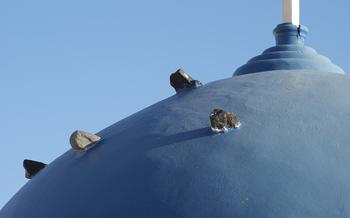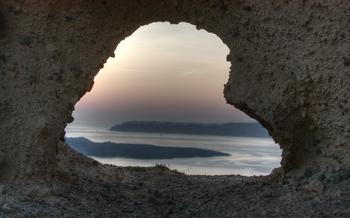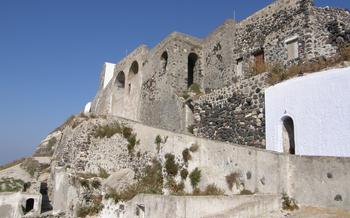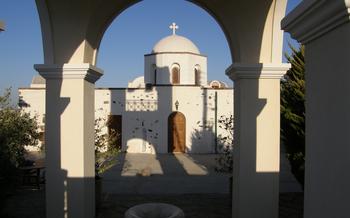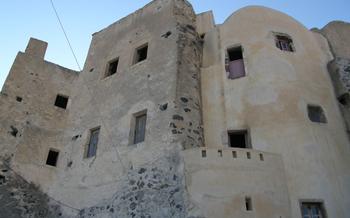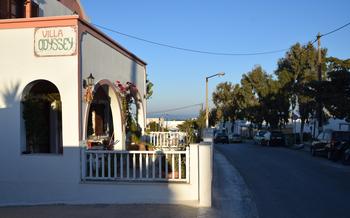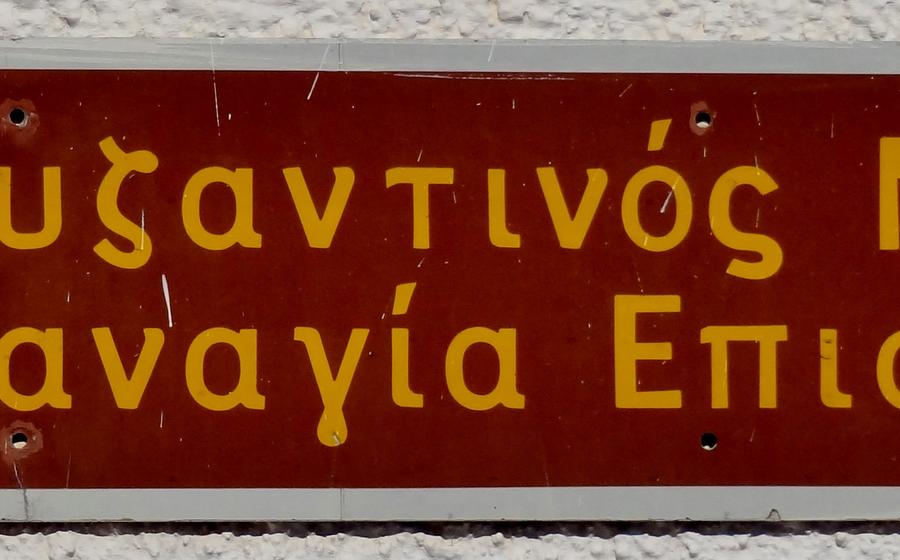
Panagia Episkopi Church
- Panagia Episkopi Church: An Architectural Masterpiece
- The Enchanting Village of Episkopi Gonia
- The Intriguing History of Panagia Episkopi
- Unveiling the Church's Stunning Interior
- Paying Homage to the Miraculous Icon
- Experiencing the Serene Atmosphere
- Exploring the Picturesque Surroundings
- Uncovering the Secrets of the Crypt
- Discovering the Local Artisans
- Joining the Annual Panigyri Festival
- Admiring the Sunset from the Churchyard
- Getting There: Practical Tips
- Insider Tip: Off-the-Beaten-Path Exploration
Panagia Episkopi Church: An Architectural Masterpiece
**Historical Significanceia Episkopi Church stands as a testament to the rich history and architectural prowess of Santorini. Its origins can be traced back to the Byzantine era, when it was constructed as a modest chapel. Over the centuries, the church underwent several renovations and expansions, notably during the Venetian period, which left an indelible mark on its architectural style.
Architectural Features:
The church boasts a unique blend of Byzantine and Venetian architectural elements. Its exterior is characterized by a simple yet elegant facade, adorned with intricate stone carvings and frescoes depicting scenes from the Bible. The interior is equally impressive, with its domed ceiling, arched doorways, and a profusion of exquisite frescoes and paintings that adorn the walls and ceiling.
Location and Accessibility:
Panagia Episkopi Church is situated in the picturesque village of Episkopi Gonia, just a short distance from the bustling town of Oia. Easily accessible by foot, car, or public transportation, the church offers visitors a serene retreat away from the throngs of tourists that flock to Santorini's more popular attractions.
The Enchanting Village of Episkopi Gonia
Episkopi Gonia, the captivating village that embraces the Panagia Episkopi Church, exudes an irresistible traditional charm. Its narrow, winding streets, adorned with whitewashed houses, create a picturesque labyrinth that whispers the secrets of Santorini's past. Bougainvillea flowers cascade over walls, adding vibrant splashes of color to the tranquil scene.
Local tavernas and shops line the charming streets, inviting visitors to savor the authentic flavors of Greek cuisine and discover unique handcrafted treasures. The tavernas, with their inviting aromas and panoramic views, offer a delightful culinary experience, while the shops showcase the talents of local artisans, from intricate ceramics and pottery to colorful woven textiles.
Strolling through Episkopi Gonia is like stepping back in time, where the traditional Greek way of life still thrives. The locals, with their warm smiles and friendly demeanor, welcome visitors with open arms, sharing stories and insights into the village's rich history and culture.
Whether you're seeking solace in the serene atmosphere of the village square, indulging in culinary delights, or simply wandering the cobblestone streets, Episkopi Gonia offers a captivating glimpse into the authentic heart of Santorini.
The Intriguing History of Panagia Episkopi
Panagia Episkopi boasts a rich and captivating history, deeply intertwined with the cultural and religious tapestry of Santorini. Its origins can be traced back to the Byzantine era, during which it served as a prominent religious center for the island's Orthodox Christian community. The church's initial construction is believed to date back to the 11th century, showcasing the distinctive architectural style prevalent during that period.
As the centuries unfolded, Santorini fell under the influence of various empires and civilizations, each leaving its unique mark on Panagia Episkopi. During the Venetian rule, which spanned from the 13th to the 16th century, the church underwent significant renovations and embellishments, reflecting the Venetian architectural influences of the time. The addition of the bell tower, with its distinctive Venetian Gothic style, stands as a testament to this era.
Despite the passage of time and the changing political landscapes, Panagia Episkopi remained a steadfast symbol of faith and resilience for the people of Santorini. In the 19th century, the church underwent extensive restoration efforts, spearheaded by the local community and supported by ecclesiastical authorities. These renovations aimed to preserve the church's historical integrity while ensuring its continued use as a place of worship and pilgrimage.
Today, Panagia Episkopi stands as a testament to the enduring spirit of Santorini's cultural heritage. Its history, marked by Byzantine origins, Venetian influences, and community-led restoration efforts, has shaped its unique character and significance, making it a must-visit destination for travelers seeking to delve into the rich tapestry of Santorini's past.
Unveiling the Church's Stunning Interior
Stepping inside the Panagia Episkopi Church is like entering a sacred art gallery. The walls and ceiling are adorned with exquisite frescoes and paintings that narrate biblical stories and depict religious figures with vibrant colors and intricate details. The iconography is a testament to the skill and artistry of the Byzantine and Venetian masters who created these masterpieces.
The domed ceiling, a hallmark of Byzantine architecture, adds to the grandeur of the interior. It's adorned with intricate patterns and mosaics that reflect the natural light streaming through the windows, creating a mesmerizing effect. This interplay of light and shadow enhances the spiritual atmosphere, inviting visitors to contemplate the divine.
The church's interior is a visual feast that captivates the senses and transports visitors to another era. It's a place where art, history, and spirituality converge, creating a profound and unforgettable experience for all who enter.
Paying Homage to the Miraculous Icon
At the heart of Panagia Episkopi lies a revered treasure that attracts pilgrims and faithful from far and wide: a miraculous icon of the Virgin Mary, known as the "Panagia Episkopi." This sacred artifact holds immense religious significance, believed to possess divine powers and the ability to grant blessings and miracles to those who seek her intercession.
Legends abound, narrating tales of miraculous healings, answered prayers, and divine interventions attributed to the icon. Devotees flock to the church to pay homage, light candles, and offer prayers before this sacred image, seeking solace, hope, and divine guidance. The icon exudes an aura of serenity and spirituality, inviting visitors to pause, reflect, and connect with their faith.
Experiencing the Serene Atmosphere
Stepping inside the Panagia Episkopi Church is akin to entering a sanctuary of tranquility, a refuge from the bustling crowds that throng the popular tourist spots of Santorini. The hushed atmosphere invites contemplation and reflection, as the soft sunlight filters through the stained-glass windows, casting a warm glow upon the ancient stone walls.
The church's simple and unadorned interior exudes a sense of peace and serenity, allowing visitors to connect with their spiritual side or simply find a moment of respite from the fast-paced world outside. The gentle scent of incense lingers in the air, adding to the aura of tranquility.
For those seeking a retreat from the hustle and bustle of Santorini, the Panagia Episkopi Church offers a serene haven, a place to immerse oneself in the beauty of Byzantine art and architecture, and to experience the profound spiritual essence of this sacred space.
Exploring the Picturesque Surroundings
Beyond the church's captivating interiors, the surrounding landscapes offer a feast for the eyes. As you step out of Panagia Episkopi, you'll be greeted by breathtaking views of the caldera, a natural wonder that has made Santorini famous worldwide. The stunning panorama of the Aegean Sea, dotted with volcanic islands, will leave you in awe.
Within the village of Episkopi Gonia itself, you'll find tranquil village squares, where time seems to stand still. These charming spaces, often adorned with colorful flowers and shaded by ancient trees, invite you to pause and soak in the peaceful ambiance. As you wander through the village's narrow streets, keep an eye out for hidden gems waiting to be discovered, such as quaint cafes, artisan workshops, and charming boutiques.
The picturesque surroundings of Panagia Episkopi offer endless opportunities for exploration. Whether you prefer to simply relax and enjoy the views, delve into the local culture, or embark on an adventurous hike, this serene corner of Santorini has something to offer every traveler.
Uncovering the Secrets of the Crypt
Beneath the Panagia Episkopi Church lies a hidden treasure - a crypt that offers a glimpse into the past. This underground burial chamber was discovered during restoration efforts and has since become an intriguing attraction for visitors. Archaeological excavations have unearthed ancient artifacts, including pottery, jewelry, and coins, providing valuable insights into the lives and customs of the people who once worshiped in this sacred space.
Exploring the crypt is a unique experience that allows you to connect with the history and spirituality of the church. As you descend into the dimly lit chamber, you can't help but feel a sense of awe and reverence. The walls are lined with ancient niches where the deceased were laid to rest, and the air is filled with a palpable sense of history.
Among the most fascinating discoveries in the crypt is a collection of well-preserved frescoes. These colorful paintings depict scenes from the Bible and the lives of the saints, offering a glimpse into the artistic and religious traditions of the time. The intricate details and vibrant colors have been meticulously restored, allowing visitors to appreciate the artistry and craftsmanship of these centuries-old masterpieces.
The crypt of Panagia Episkopi is a hidden gem that offers a unique perspective on the history and significance of this remarkable church. Whether you are a history buff, an art enthusiast, or simply seeking a deeper connection with the past, a visit to the crypt is an unforgettable experience that will leave you with a lasting impression.
Discovering the Local Artisans
Santorini is renowned for its vibrant artistic community, and Episkopi Gonia is no exception. The village is home to talented artisans who have mastered traditional crafts, preserving the rich cultural heritage of the island.
In the heart of Episkopi Gonia, visitors can find charming workshops and studios where local artisans showcase their unique creations. Ceramics, pottery, and weaving are among the most popular crafts practiced in the village.
Ceramics and Pottery:
Local ceramicists and potters use local clay to create beautiful and functional pieces that reflect the unique style of Santorini. From intricate vases and decorative plates to hand-painted tiles, each piece is a testament to the skill and artistry of the craftsmen.
Weaving:
The art of weaving has been passed down through generations in Episkopi Gonia. Artisans use traditional techniques and natural fibers to create colorful textiles, rugs, and tapestries that add a touch of warmth and authenticity to any home.
Visiting the workshops and studios of local artisans is an excellent way to support the preservation of traditional crafts and bring home a unique souvenir that captures the essence of Santorini. Whether you are looking for a one-of-a-kind piece of pottery, a handwoven rug, or a delicate ceramic gift, Episkopi Gonia has something for every taste and budget.
Engage with the artisans, learn about their creative process, and appreciate the skill and dedication that goes into each handmade piece. Take home a piece of Santorini's artistic heritage and treasure it as a reminder of your visit to this charming village.
Joining the Annual Panigyri Festival
Every year, the village of Episkopi Gonia comes alive with the vibrant Panigyri festival, a celebration honoring the church's patron saint. The atmosphere is electric as locals and visitors gather to partake in the festivities. The streets are adorned with colorful decorations, and the air is filled with the sounds of traditional Greek music and laughter.
During the Panigyri, the village square transforms into a lively dance floor, where locals and visitors alike showcase their dancing skills. The traditional Greek dances, such as the sirtaki and the zeibekiko, are a sight to behold, and everyone is welcome to join in. The energy is infectious, and the atmosphere is one of pure joy and camaraderie.
In addition to the dancing, the Panigyri offers a variety of traditional Greek food and drinks. Visitors can indulge in delicious grilled meats, fresh seafood, and local specialties, all prepared with love and care. The local tavernas and cafes set up stalls in the square, offering a tempting array of culinary delights.
The Panigyri is not just a celebration of the church's patron saint but also a celebration of the local culture and traditions. It is an opportunity for visitors to immerse themselves in the vibrant atmosphere of a Greek village and experience the warmth and hospitality of the local people.
Admiring the Sunset from the Churchyard
As day draws to a close, the Panagia Episkopi Churchyard transforms into a magical viewing platform for one of Santorini's most iconic spectacles—the sunset. With the Aegean Sea as your backdrop, you'll witness the sky morph into a canvas of blazing colors, from deep oranges to vibrant purples. The golden hues illuminate the whitewashed houses of Episkopi Gonia, creating a picture-postcard-perfect scene.
Feel free to linger in the churchyard, enjoying the tranquility and embracing the beauty that surrounds you. Capture the breathtaking views with your camera, immortalizing the memory of this special moment. Whether you're a seasoned photographer or simply seeking a unique travel experience, this is a must-do activity in Santorini.
As the sun dips below the horizon, take a moment to reflect on the rich history and spiritual significance of the Panagia Episkopi Church. Let the tranquility of the surroundings wash away your worries, leaving you with a sense of peace and serenity.
Getting There: Practical Tips
Reaching the Panagia Episkopi Church involves a scenic journey through the enchanting landscapes of Santorini. Whether you prefer public transportation, a private vehicle, or a leisurely walk, there are several options to suit your preferences.
Public Transportation:
- Bus: Regular bus services connect Fira, the island's capital, with Episkopi Gonia. The journey takes approximately 30 minutes, offering breathtaking views along the way.
Private Transportation:
- Car or Scooter Rental: Renting a car or scooter is a convenient option for exploring Santorini at your own pace. It allows you to set your itinerary and make spontaneous stops along the way. Parking is available near the church, ensuring a hassle-free visit.
Walking or Donkey Ride:
-
Walking: For those seeking a more immersive experience, embarking on a leisurely walk from Fira to Episkopi Gonia is a rewarding option. The picturesque route offers stunning views of the caldera and the surrounding countryside.
-
Donkey Ride: For a unique and traditional experience, consider taking a donkey ride from Fira to the church. This leisurely journey allows you to soak in the beauty of the surroundings while enjoying a memorable adventure.
Insider Tip: Off-the-Beaten-Path Exploration
While the Panagia Episkopi Church is a must-see attraction in Santorini, there are many other hidden gems waiting to be discovered for those willing to venture off the beaten path. Explore the charming village of Episkopi Gonia, with its narrow streets, whitewashed houses, and traditional tavernas. Discover lesser-known churches in Santorini, such as the Panagia Theoskepasti in Imerovigli or the Panagia Platsani in Pyrgos, each with its own unique charm and history. For an unforgettable experience, take a donkey ride through the picturesque surroundings, offering breathtaking views of the caldera and the serene countryside. Embrace the opportunity to immerse yourself in the authentic culture and traditions of Santorini, creating memories that will last a lifetime.
